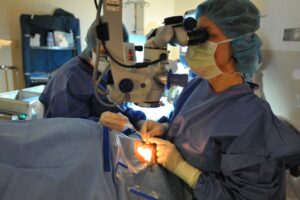If you are scheduled for cataract surgery, it’s important to be aware of the risks and potential complications involved. While cataract surgery is one of the most common procedures performed, it’s not without its risks. In this blog post, we will discuss some of the more common complications and risks associated with cataract surgery. Knowing what to expect can help you make a more informed decision about whether or not to have the procedure done.
What Is Cataract Surgery?
 Cataract surgery is the procedure of removing the natural lens of the eye that has become cloudy or opaque. The cloudy lens is replaced with a clear artificial intraocular lens (IOL). Cataract surgery is performed under local anesthesia and does not require an overnight hospital stay. The surgery usually takes less than 30 minutes to perform.
Cataract surgery is the procedure of removing the natural lens of the eye that has become cloudy or opaque. The cloudy lens is replaced with a clear artificial intraocular lens (IOL). Cataract surgery is performed under local anesthesia and does not require an overnight hospital stay. The surgery usually takes less than 30 minutes to perform.
There are two types of cataract surgery: traditional phacoemulsification and laser-assisted cataract surgery (LACS). Phacoemulsification is the most common type of cataract surgery. It uses an ultrasonic device to break up the cloudy lens into small pieces that are then suctioned out of the eye. This type of surgery is usually performed on an outpatient basis. Laser-assisted cataract surgery (LACS) uses a laser to create incisions in the eye and break up the cloudy lens. LACS is often used for patients who have harder-to-treat cataracts. This type of surgery may require a longer recovery time than phacoemulsification.
It is important to note that cataract surgery is considered a very safe procedure. Complications from cataract surgery are rare, but they can occur.
What Are The Cataract Surgery Complications And Risks?
Cataract surgery is a very safe procedure, but as with any surgery, there are risks and potential complications involved. Knowing what to expect can help you make a more informed decision about whether or not to have the procedure done.
Primary Risks
As mentioned above, there are some risks associated with cataract surgery. These risks are considered to be primary risks, which means that they are directly related to the surgery itself. Some of the more common primary risks include:

- Infection: Infection is a rare complication of cataract surgery, but it can occur. The risk of infection is usually low if the surgery is performed by a skilled and experienced surgeon.
- Bleeding: Bleeding can occur during or after surgery. This is usually a minor complication that can be easily treated. However, in rare cases, bleeding can lead to more serious complications such as retinal detachment.
- Swelling: Swelling of the eye is a common complication of cataract surgery. This usually subsides within a few days or weeks.
- Fluid build-up: Fluid can build up in the eye after surgery. This is called a choroidal effusion. If this occurs, it may require additional treatment.
- Dry eye: Dry eye is a common complication of cataract surgery. It can occur when the tear ducts are damaged during surgery. This can lead to symptoms such as itching, burning, and redness.
- Lens dislocation: In rare cases, the artificial lens can become dislodged from its position. This usually requires another surgery to correct.
- Night vision problems: Night vision problems are common after cataract surgery. They can occur when the pupil becomes enlarged or when the artificial lens is not placed in the correct position.
These are just some of the more common primary risks associated with cataract surgery
Secondary Risks
There are also some secondary risks associated with cataract surgery. These risks are not directly related to the surgery itself but can occur as a result of the surgery. Some of the more common secondary risks include:
- Glare: Glare is a common problem after cataract surgery. It can occur when light reflects off of the artificial lens. This can make it difficult to see.
- Halo effect: The halo effect is another common problem after cataract surgery. It can occur when light reflects off of the artificial lens and creates a halo around objects.
- Macular degeneration: Macular degeneration is a condition that can occur when the center of the retina (the macula) starts to deteriorate. This may be a result of the surgery itself or it may be a pre-existing condition that is exacerbated by the surgery.
- Cataract recurrence: In rare cases, the cataract may return after surgery. This usually happens if the artificial lens is not placed correctly or if there is still some cloudiness in the natural lens.
As you can see, there are some potential risks associated with cataract surgery. However, it is important to remember that these complications are rare.
Cataract surgery complications can be divided into two main categories: early and late complications. Early complications are those that occur within the first few days or weeks after surgery. Late complications can occur months or even years after surgery. The key difference between them is that early complications are typically more serious and can lead to more serious consequences.
Early Complications
The most common early complication is endophthalmitis, which is an inflammation of the eye. This can occur when bacteria enter the eye during surgery. Symptoms of endophthalmitis include redness, pain, and decreased vision. Treatment typically involves a course of antibiotics or antifungal medication. In some cases, surgery may also be necessary.
Another early complication from cataract surgery is infection. Infection rates after cataract surgery are very low, occurring in less than one percent of cases. However, when they do occur, they can be very serious. Infections after cataract surgery can lead to serious consequences, such as vision loss.
Another common early complication is iritis, which is an inflammation of the iris (the colored part of the eye). Symptoms of iritis include redness, pain, and decreased vision. Treatment typically involves a course of steroids. In some cases, surgery may also be necessary.
Late complications

The most common late complication is posterior capsular opacification (PCO), also known as cloudy vision. Symptoms of PCO include decreased vision and glare. PCO occurs when the back of the artificial intraocular lens (IOL) becomes cloudy. This can happen months or even years after surgery. PCO is usually treated with a laser procedure called YAG capsulotomy.
Another common late complication is glaucoma. This is an increase in pressure inside the eye that can damage the optic nerve. Symptoms of glaucoma include decreased vision, pain, and redness. Treatment typically involves medication or surgery.
Moreover, cataract surgery can also lead to retinal detachment. This is when the retina (the light-sensitive layer at the back of the eye) becomes separated from the rest of the eye. Symptoms of retinal detachment include floaters, flashes of light, and decreased vision. Treatment typically involves surgery.
Lastly, the most serious complication of cataract surgery is vision loss. This can occur if the other complications are not treated properly or in a timely manner. It can also occur if the surgery is not performed correctly.
As you can see, there are some potential risks associated with cataract surgery. However, it is important to remember that these complications are rare. If you experience any symptoms after your surgery, be sure to contact your doctor immediately. With prompt treatment, most complications can be resolved without any lasting effects.
How To Manage Them?
 Now that we are aware of the various complications that can occur post-cataract surgery, it becomes important to know how we can manage them. The best way to avoid any complications is to have regular follow-ups with your ophthalmologist.
Now that we are aware of the various complications that can occur post-cataract surgery, it becomes important to know how we can manage them. The best way to avoid any complications is to have regular follow-ups with your ophthalmologist.
It is also important to take good care of your eye and avoid any injury to it. In case you experience any symptoms that concern you, do not hesitate to reach out to your doctor immediately. With proper care and timely treatment, most complications and risks can be managed/prevented with minimal side effects or harm.
Moreover, there are also some measures that can be taken to reduce the risk of complications. For instance, certain medications such as steroids and non-steroidal anti-inflammatory drugs (NSAIDs) should be avoided before and after surgery. Additionally, it is important to follow all the instructions given by your doctor before and after surgery. This includes using the eye drops prescribed by your doctor and avoiding activities that can put a strain on your eyes.
By following these simple tips, you can significantly reduce your risk of developing any complications after cataract surgery.
Conclusion
In conclusion of the above, cataract surgery is a relatively safe and effective procedure. However, as with any surgery, there are some risks and potential complications associated with the procedure. So, if you are scheduled for cataract surgery, be sure to keep all of these potential complications in mind. And, if you experience any symptoms afterward, do not hesitate to contact your doctor immediately.
At EyeMantra we have a team of experienced eye surgeons, who will be happy to answer your any questions on cataract surgery, cataract surgery cost, cataract lens cost for different cataract surgery types- Phacoemulsification, MICS & Femto Laser Cataract . Call us at +91-9711116605 or email at [email protected] for inquiries.


